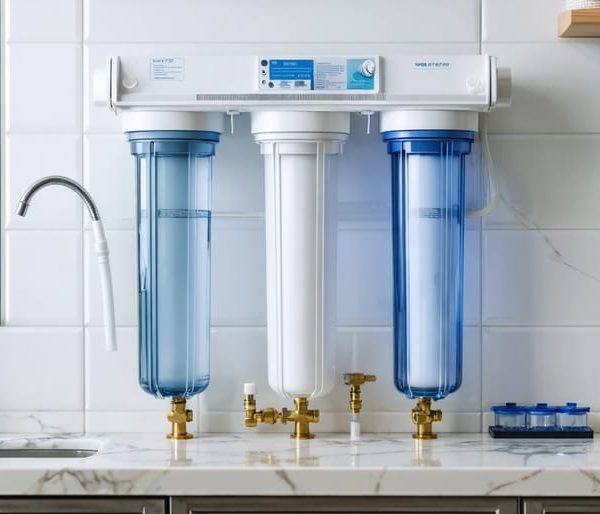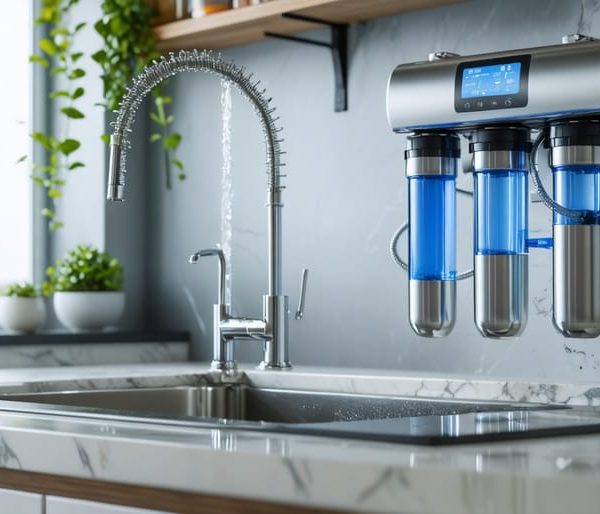The pH of a water sample is the degree of acidity and alkalinity in that water. The neutral pH level of pure water is 7. The numerical pH value ranges from a scale of 0 to 14, based on the quality of the water. Highly acidic water can be detrimental to your health. The same applies to highly alkaline water. That’s why it’s good to know how to test the pH of water without a kit, in the absence of a pH meter.
Many homeowners use a reverse osmosis water filter for purifying their drinking water, and it’s very effective in eliminating contaminants. However, the end product of reverse osmosis filtration is acidic water, which doesn’t contain beneficial minerals.
In this case, an alkaline water filter will neutralize acidic water and restore pH levels to a normal range, making it suitable for drinking.
Before we delve into the process of testing water pH without a pH testing kit, you should first know why you should test your water ph.
Six Ways to Test pH of Water Without a Kit
There are some DIY methods that you can use for testing the pH of water without a kit. They include red onions, blueberries, and red cabbage.
1. Red Cabbage to Test pH of Water
This step-by-step guide will show you how you can use this vegetable to determine your water ph.
First, you need to make a pH solution and have litmus paper (both red litmus paper and blue litmus paper) and red cabbage.
This pH test will be carried out using a red cabbage juice indicator. We’ll also show you how to make it. This pH indicator is simple and very effective for water pH testing because it provides different colors to test water pH.
To make this indicator, follow the steps below:
- Cut your red cabbage into tiny strips.
- Transfer the red cabbage strips from the chopping board to a pan or pot and pour water.
- Boil the water till you see the color changing to purple-red.
- Switch off the stove and take out the cabbage strips.
- Turn this water into some containers and label them.
This is your pH indicator solution, placed into some containers. To use this to test the pH of water, add some water into these containers. Now, wait for about 2-3 minutes, and notice the color of the water.
If the water changes color to pink or red, it means the water is acidic. If the water is still purple, the pH scale is neutral. If the water changes color to either bluish-green or blue, it’s alkaline water.

Alternative Method: Using Red Cabbage Indicator to Make pH Test Strips
An alternative way to use a cabbage juice indicator for testing pH is to soak a filter paper or coffee filter in cabbage juice and then dry them. Once dried, you have a homemade pH test strip. These pH testing strips can be placed directly in your water to test them.
2. Blueberries for pH Testing
The dark blue pigmentation of Blueberries is derived from a chemical known as peonidin. This chemical is sensitive to acidic or alkaline response, making it sensitive to water ph.
In its original or neutral state, this chemical is vibrant and colorful. However, when it reacts with alkaline, it becomes darker in color and loses its vibrancy.
Follow the steps below to make your blueberry pH indicator:
- Use a knife to cut your blueberries into small pieces on your chopping board. The pigment-inducing chemical is in the skin of the fruit. So to get more accurate results from your pH test, ensure you separate the pulp from the skin.
- Place these strips of skin into a pot and add water, then boil it for a maximum of 15 minutes. Add more water if the one in the pot dries up.
- After it boils for the recommended period, remove the pot from your stove and let your blueberry solution cool for a while.
- Use a coffee filter to sieve this solution and collect the filtered liquid in a small jar. You may use your spoon to apply a little pressure on the filter to squeeze more juice out of it. The liquid will be purplish red.
- Use an eyedropper to get some of the liquid from the jar.
- Apply a few drops of this liquid on a surface, preferably a flat plate.
- Use clean water to rinse this dropper, then use it to apply little water into the blueberry solution.
If acidic, the purplish-red hue will transform to a lighter shade, pink or red.
3. Red Onions to Test Water pH
Like several vegetables, red onions contain anthocyanin, which is sensitive to pH (acidic and alkaline). Like blueberries and red cabbage, you use the same process to make a red onions solution. Then you apply drops of water into the solution. If the water is acidic, the solution will become pale red. The color will change to green in basic or neutral solutions.
4. Soap Scum
Soap scum is formed when soap mixes with hard water. Hard water contains minerals such as magnesium and calcium carbonate. The buildup of soap scum on your bathroom fixtures can be challenging to eliminate because there will be soap scum every time you take your bath. So if you have a huge buildup of soap scum in your bathroom, then could mean your water is alkaline because of its high mineral content.
5. Litmus Paper
If you are without a kit to test the water pH, universal litmus paper is a good alternative.
It’s universally regarded as a pH indicator that can sense the alkalinity or acidity of a water sample. Unfortunately, there are only two kinds of readings with litmus paper, and there’s no pH color chart to illustrate the degree of alkalinity or acidity of water.
There are two other types of litmus paper; red litmus paper and blue litmus paper. When you insert a red litmus paper into an alkaline solution, the color will change to blue. On the other hand, if you insert a blue litmus paper into an acidic solution, the color will change to red. Finally, if you insert either the red or blue litmus paper into a neutral solution, it will retain its original color.
6. Digital pH Meter
Using a digital pH meter to test for pH is the most reliable testing method. One reason is that there’s no room for human error, and there’s no need to use colored liquids for your test. Your pH readings will be displayed on the screen once you dip the pH meter into the water sample. It doesn’t just stop here; a pH meter will also sense contaminants in the water that are tampering with the water test.
Unlike pH testing strips, they don’t have an expiry date or storage problems. It also doesn’t depend on color variations. Once you depend on its glass electrode in water, the readings will be displayed on its screen. To ensure the meter is accurate, you can test it with a fixed pH solution. After confirmation, rinse the electrode with distilled water and dry it with a clean cloth before testing your water.
What Makes Water Acidic or Alkaline?

Water comes naturally from mountain glaciers and rainfall. Water then travels into rivers and streams and picks up several minerals along the way, making it alkaline. Underground water can be either acidic or alkaline, depending on the storage situation.
Water can become acidic through pollution, for instance, acid rain. Another way is through reverse osmosis filtration.
Water pH levels have to be monitored or tested regularly because they can change according to the source of water and the environment.
Either highly alkaline or acidic water is not suitable for consumption, and consumption over time can trigger health complications.
Despite the availability of pH water testing kits, you can also execute the DIY methods you’ve seen to test the pH of your water.



